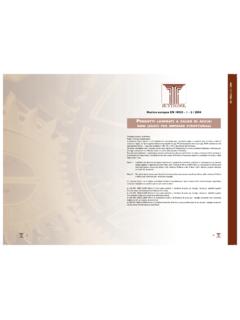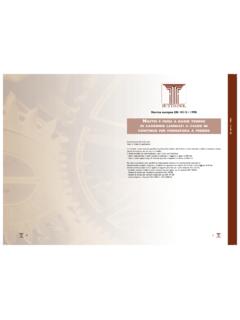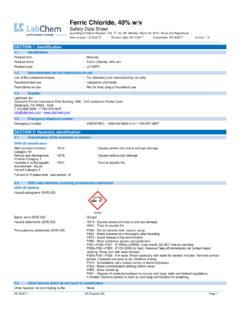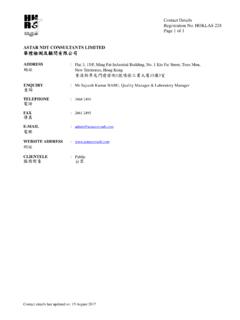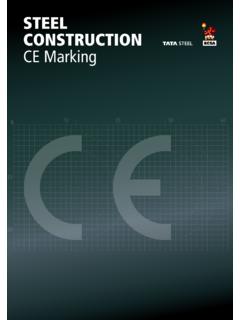Transcription of KTA 3902 (2012-11) Design of Lifting Equipment in Nuclear ...
1 Safety Standards of the Nuclear Safety Standards Commission (KTA) kta 3902 (2012-11) Design of Lifting Equipment in Nuclear Power Plants(Auslegung von Hebezeugen in Kernkraftwerken)Previous versions of this Safety Standard were issued 1975-11, 1978-06, 1983-11, 1992-06 and 1999-06 If there is any doubt regarding the information contained in this translation, the German wording shall apply. Editor: KTA-Geschaeftsstelle c/o Bundesamt fuer Strahlenschutz (BfS) Willy-Brandt-Strasse 5 38226 Salzgitter Germany Telephone +49-30-18-333-1621 Telefax +49-30-18-333-1625 KTA SAFETY STANDARD 2012-11 Design of Lifting Equipment in Nuclear Power Plants kta 3902 CONTENTS Fundamentals.
2 5 1 Scope .. 5 2 Definitions .. 5 3 General provisions .. 5 4 Special provisions .. 5 Elevators in containment vessels .. 5 Cranes, winches, trolleys and load suspending devices with additional requirements .. 5 Cranes, winches, trolleys and load suspending devices with increased requirements .. 5 Refueling machines for light water reactors .. 6 External events .. 6 Ambient conditions .. 6 Ergonomics requirements .. 6 5 Elevators in containment vessels .. 6 General 6 Personnel elevators and freight elevators .. 6 Elevator shaft .. 6 6 Additional requirements for cranes, winches, trolleys and load-attachment and load suspending 8 Load support 8 Hoists.
3 8 Lateral transport 10 Load-attachment and load suspending devices .. 10 Electrical Equipment .. 11 7 Increased requirements for cranes, winches, trolleys and load-attachment and load suspending 14 Load support 14 Hoists .. 14 Lateral transport drives ..15 Load-attachment and load suspending devices ..15 Electrical Equipment ..16 8 Requirements for refueling machines for light water Load support structures ..16 Lateral transport drives ..18 Load-attachment and load suspending devices ..18 Electrical Equipment ..19 Annex A: Examples for classification of Lifting Annex B: Load cases and analytical proofs for Lifting Equipment .
4 22 Annex C: Stress-number diagram for the analysis of cyclic loading and endurance limit of the materials S235 and S355 to DIN EN 10025-2 ..38 Annex D: General stress analysis and stress-number diagrams for the analytical proof of cyclic operation and endurance limit of the steels , and to DIN EN 10088-2 or DIN EN 10088-3 ..44 Annex E: Required Performance Levels to DIN EN ISO 13849-1 for function of safety-related parts of control Annex F: Regulations and literature referred to in this Safety Standard ..59 Literature: ..62 Annex G: Changes with respect to the edition 1999-06 and explanations (informative) ..63 PLEASE NOTE: Only the original German version of this safety standard represents the joint resolution of the 50-member Nuclear Safety Standards Commission (Kerntechnischer Ausschuss, KTA).
5 The German version was made public in Bundesanzeiger (BAnz) of January, 23th, 2013. Copies may be ordered through the Wolters Kluwer Deutschland GmbH, Postfach 2352, 56513 Neuwied, Germany (Telefax +49 (0) 2631 801-2223, E-Mail: All questions regarding this English translation should please be directed to: KTA-Geschaeftsstelle c/o BfS, Willy-Brandt-Strasse 5, 38226 Salzgitter, Germany KTA Page 4 Comments by the editor: Taking into account the meaning and usage of auxiliary verbs in the German language, in this translation the fol-lowing agreements are effective.)
6 Shall indicates a mandatory requirement, shall basically is used in the case of mandatory requirements to which specific exceptions (and only those!) are permitted. It is a requirement of the KTA that these exceptions - other than those in the case of shall normally - are specified in the text of the safety standard, shall normally indicates a requirement to which exceptions are allowed. However, the exceptions used, shall be substantiated during the licensing procedure, should indicates a recommendation or an example of good practice, may indicates an acceptable or permissible method within the scope of this safety standard.
7 kta 3902 Page 5 Fundamentals (1) The Safety Standards of the Nuclear Safety Standards Commission (KTA) have the task of specifying those safety related requirements which shall be met with regard to precau-tions to be taken in accordance with the state of science and technology against damage arising from the construction and operation of the facility (Sec. 7 para 2 subpara 3 Atomic En-ergy Act -AtG -) in order to attain the protection goals specified in the Atomic Energy Act and the Radiological Protection Or-dinance (StrlSchV) and which are further detailed in the Safety Criteria for Nuclear Power Plants and in the Incident Guidelines.
8 (2) Based on the Safety Criteria for Nuclear Power Plants issued by the Federal Minister of the Interior, this safety stan-dard specifies the Design criteria for Lifting Equipment . Addi-tionally, Lifting Equipment shall be erected and operated in accordance with the valid federal and state safety regulations as well as with the regulations of the official accident insur-ance institutions. (3) Regarding the danger potential, the Design shall be based on a) additional requirements or b) increased requirements for Lifting Equipment which exceed the general provisions, as well as c) requirements for elevators in reactor containments and d) requirements for refuelling machines as specified in this safety standard in detail.
9 (4) General requirements regarding quality assurance are specified in Safety Standard KTA 1401. (5) The requirements for inspection, testing and operation, including specific requirements for quality assurance, are laid down in KTA 3903. 1 Scope This safety standard applies to the Design of elevators, cranes, winches, trolleys, load suspending devices and refuel-ing machines of light water reactors, collectively called Lifting Equipment in the following, in as far as they are used in Nuclear power plants and meet the special provisions of Section 4. 2 Definitions (1) Maximum operational load The maximum operational load is the load which is moved with the Lifting Equipment during specified normal operation.
10 (2) Refueling machines for light water reactors A refueling machine for light water reactors is that Equipment which is directly used to charge the reactor core with fuel assemblies or control rods ( shim or shutdown rods), or to discharge these from the core. (3) Lifting capacity The Lifting capacity is the sum of maximum erection load or maximum operational load and the dead weights of the com-ponents to take up the load to be handled, bottom block, Lifting beam, and the weight of the load carrying means, of the rope. (4) Load suspending device Load suspending devices are load carrying means, load carry-ing attachment and load attachment riggings.


